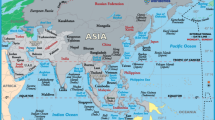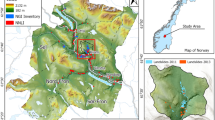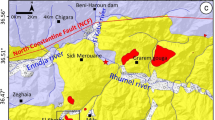Abstract
Scientific activities of the World Centre of Excellence on Landslide Disaster Reduction at Charles University in Prague (2011–2014) combine field research using several techniques, capacity building, and international collaboration. Through our landslide research in Peru, Ethiopia, and at several localities inside the Czech Republic, we consider the landslide phenomena as being a part of the physical-geographical sphere where all of the interactions between the lithosphere, atmosphere, and hydrosphere must be evaluated with respect to specific on-site conditions. Slope deformations are also considered as ongoing landscape changes in time and space. In some regions (e.g., in the Cordillera Blanca, Peru), landslides were studied as they occurred. In addition to progress in research methodologies, we have created a new glacial lake outburst floods (GLOFs) database. Doctoral candidates were involved in field research and student exchanges. Field studies also involve foreign students. Aspects of our landslide research are a matter of international collaboration in the framework of the International Programme on Landslides (IPL).



Similar content being viewed by others
References
Alcantara-Ayala I, Oliver-Smith A (2014) ICL Latin-American Network: on the road to landslide reduction capacity building. Landslides 11(2):315–318
Blahut J, Smolíkova J, Vilímek V (2012) Reconstruction of debris flows from Smědavská hora Mt., using a regional run out model. Geoscience Research Reports for 2011 66:69
Burda J (2011) Spatio-temporal activity of mass movements in the Krušné hory mountains (Czech Republic): dendrogeomorphological case study. AUC Geographica 46(2):15–30
Caceres R (2007) Movimiento límite de los bosques de Polylepis en relación al retroseco glaciar en la microcuenca Quillcay–Ancash. AUC Geographica 42(1-2):183–206
Carey M, Huggel C, Bury J, Portocarrero C, Haeberli W (2012) An integrated socioenvironmental framework for glacier hazard management and climate change adaptation: lessons from Lake 513, Cordillera Blanca, Peru. Climatic Change 112(3-4):733–767
Emmer A, Cochachin A (2013) The causes and mechanisms of moraine-dammed lake failures in the Cordillera Blanca, North American Cordillera, and Himalaya. AUC Geographica 48(2):5–15
Emmer A, Vilímek V (2013) Review article: lake and breach hazard assessment for moraine-dammed lakes: an example from Cordillera Blanca (Peru). Natural Hazards and Earth System Science 13:1551–1565
Emmer A, Vilímek V, Klimeš J, Cochachin A (2014) Glacier retreat, lakes development and associated natural hazards in Cordillera Blanca, Peru. In: W. Shan et al. Eds.: Landslides in cold regions in the context of climate change, environmental science and engineering, DOI: 10.1007/978-3-31900867-7_17, Springer, p. 231-252
Emmer A, Vilímek V (2014) New method for assessing the potential hazardousness of glacial lakes in the Cordillera Blanca, Peru. Hydrology and Earth System Science 18:346–13479
Goudie AS, Kalvoda J (1997) The study of environmental hazards in extreme environments as a frontier for physical geography. AUC Geographica 32(2):11–14
Kalvoda J, Klokočník J, Kostelecký J (2010) Regional correlation of the Earth Gravitational Model 2008 with morphogenetic patterns of the Nepal Himalaya. AUC Geographica 45(2):53–71
Kalvoda J, Klokočník J, Kostelecký J, Bezděk A (2013) Mass distribution of Earth landforms determined by aspects of the geopotential as computed from the global gravity field model EGM 2008. AUC Geographica 48(2):17–25
Klimeš J, Benešová M, Vilímek V, Bouška P, Cochachin AR (2014) The reconstruction of a glacial lake outburst flood using HEC-RAS and its significance for future hazard assessments: an example from Lake 513 in the Cordillera Blanca, Peru. Natural Hazards 71(3):1617–1638
Klimeš J, Vilímek V, Omelka M (2009) Implications of geomorphological research for recent and prehistoric avalanches and related hazards at Huascaran, Peru. Natural Hazards 50(1):193–209
Klimeš J, Vilímek V (2011) A catastrophic landslide near Rampac Grande in the Cordillera Negra, northern Peru. Landslides 8(3):309–320
Křížek M, Kusák M (2014) Variability of the morphometric characteristics of valley networks caused by variations in a scale. AUC Geographica 49(1):33–42
Kusák M (2014) Review article: methods of fractal geometry used in the study of complex geomorphology networks. AUC Geographia 99–110
Maca V (2015) The susceptibility analysis of slope movements in the Jemma River basin (Ethiopian Highland). MS Charles University in Prague (in Czech), 89 p
Mikos M (2012) The ICL landslide monitoring and warning thematic network. Landslides 9(4):565–569
Sassa K (2012) ICL strategic plan 2012-2021—to create a safer geo-environment. Landslides 9(2):155–164
Smolíková J, Blahut J, Vilímek V (2015) Analysis of rainfall preceding debris flows on the Smědavská hora Mt., Jizerské hory Mts., Czech Republic. Landslides p 14. doi:10.1007/s10346-015-0601-6
Tumajer J, Burda J (2013) Landslide-induced changes of vessel shape in Betula pendula Roth. A preliminary study. AUC Geographica 48(1):59–68
Vařilová Z., Kropáček J., Zvelebil J., Šťastný M., Vilímek V. (in print, 2015): Reactivation of mass movements in Dessie graben, the example of an active landslide area in the Ethiopian Highlands. Landslides. doi:10.1007/s10346-015-0613-2
Vilímek V, Zvelebil J, Klimeš J, Vlčko J, Astete FV (2005) Geomorphological investigations at Machu Picchu, Peru (C 101-1). In: Sassa K, Fukuoka H, Wang F, Wang G eds. (2005) Landslides: risk analyses and sustainable disaster management. Springer, p. 49-56
Vilímek V, Emmer A, Huggel C, Schaub Y, Würmli S (2014) Database of glacial lake outburst floods (GLOFs)—IPL Project No. 179. Landslides 11(1):161–165
Vilímek V, Zvelebil J, Kalvoda J, Šíma J (2010) Landslide field research and capacity building through international collaboration. Landslides 7(3):375–380
Acknowledgments
The authors would like to thank the Grant Agency of the Czech Republic (GACR P209/12/J068) and Grant Agency of Charles University in Prague, Czech Republic (GAUK 425911/2011), for their financial and scientific support. The manuscript was reviewed and edited by Dr. David Huntley, Geological Survey of Canada, Vancouver, Canada.
Author information
Authors and Affiliations
Corresponding author
Rights and permissions
About this article
Cite this article
Vilímek, V., Smolíková, J. Scientific research for landslide risk analysis and international education for mitigation and preparedness. Landslides 12, 1227–1231 (2015). https://doi.org/10.1007/s10346-015-0636-8
Received:
Accepted:
Published:
Issue Date:
DOI: https://doi.org/10.1007/s10346-015-0636-8




